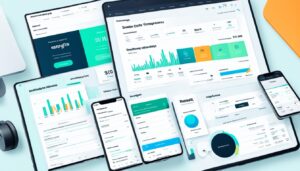As a brand owner or manufacturer, your product’s price can have a significant impact on your business. However, enforcing consistent pricing across channels is not always straightforward. This is where MAP (Minimum Advertised Price) monitoring comes in, ensuring pricing compliance and safeguarding your brand’s integrity.
MAP monitoring is the process of tracking and enforcing the minimum advertised price for your product across all channels. By keeping a close eye on pricing violations, brands can maintain a level playing field and protect their image from price reductions that could indicate lower quality or value.
Effective MAP monitoring solutions provide real-time price tracking, automated alerts, and data analytics to optimize your pricing strategy. With the right tools, brands can stay ahead of MAP violations, proactively enforce pricing policies, and set competitive yet compliant prices.
Key Takeaways:
- MAP monitoring is essential for brands to maintain pricing compliance and safeguard their image
- Enforcing consistent pricing across channels ensures fair competition and protects a brand’s value perception
- Effective MAP monitoring solutions offer real-time tracking, automated alerts, and data analytics, optimizing pricing strategy
- Proactive enforcement of pricing policies is crucial to maintaining compliance and a level playing field
- Competitive yet compliant pricing can be achieved through market research, competitive analysis, and dynamic pricing strategies
Understanding MAP Monitoring
MAP monitoring refers to the process of keeping track of Minimum Advertised Prices (MAPs) for a brand’s products across different channels, such as online marketplaces, physical stores, and e-commerce platforms. Minimum Advertised Prices are the lowest prices that a seller is allowed to advertise for a particular product. MAP monitoring allows brands to detect and enforce MAP compliance, ensuring fair pricing and protecting their brand integrity.
Effective MAP tracking enables brands to identify instances of MAP violations and take action against them. Monitoring prices on a regular basis also shows brands how their products are priced relative to those of competitors. Such data can enable a brand to adjust their prices in response to market trends, enhancing their competitiveness.
“MAP monitoring is essential for all brands that want to maintain a level playing field across different channels,” said Jane
How MAP Monitoring Works
MAP monitoring involves tracking prices across different channels and identifying instances of price deviations. The goal is to detect MAP violations – instances in which sellers are advertising products below their manufacturer-mandated minimum advertised price. Brands may use MAP monitoring software or MAP monitoring tools to automate the process and get real-time notifications of MAP violations. This can help brands to take swift action against MAP violators and maintain pricing compliance.
While MAP monitoring primarily aims to prevent sellers from advertising below minimum prices, it can also be used to optimize prices. By analyzing data on product prices across channels and competitors, brands can gain insights on pricing trends and make informed pricing decisions.
The Importance of MAP Monitoring
MAP monitoring is crucial for maintaining fair pricing practices, protecting brand integrity, and preventing price wars among competitors. Brands that do not monitor MAP compliance risk losing control over their product pricing, leading to price erosion, brand devaluation, and lost revenues.
For instance, a study conducted by Price Consulting Group revealed that brands that implemented MAP monitoring software experienced a 12% increase in sales revenue within six months, compared to brands that did not use any monitoring solutions.
The Benefits of MAP Monitoring Software
MAP monitoring software is an essential tool for brands looking to optimize their pricing strategies. Real-time price tracking, automated alerts, and data analytics are just a few of the many benefits that such software has to offer.
With MAP monitoring software, brands can track the prices of their products and those of their competitors, enabling them to adjust their prices accordingly and stay ahead of the competition. Automated alerts keep brands informed of any MAP violations, allowing for swift action to be taken to ensure pricing compliance and safeguard brand integrity.
Data analytics are another key feature of MAP monitoring software, providing valuable insights into pricing trends and consumer behavior. The ability to analyze this data can lead to more informed pricing decisions, boosting sales and revenue.
Overall, MAP monitoring software empowers brands to optimize their pricing strategies, stay compliant with MAP policies, and maintain their competitive edge in the market.
Example Table: Features of MAP Monitoring Software
| Feature | Description |
|---|---|
| Real-time price tracking | Allows for instant updates on pricing changes across multiple channels and retailers. |
| Automated alerts | Sends notifications whenever a MAP violation occurs, ensuring prompt action to maintain pricing compliance. |
| Data analytics | Provides valuable insights into consumer behavior and pricing trends, enabling more informed pricing decisions. |
| Competitor analysis | Allows brands to monitor the prices of their competitors and adjust their own pricing strategies accordingly. |
| Customizable reporting | Enables brands to create tailored reports to track pricing trends and compliance over time. |
Key Features of MAP Monitoring Tools
MAP monitoring tools offer a variety of features that make it easier for brands to monitor their pricing and enforce their MAP policies. Here are some key features to look for:
| Feature | Description |
|---|---|
| Real-time price tracking | Automatically track prices across various channels in real-time to identify pricing violations. |
| Competitor analysis | Monitor competitor pricing strategies to stay competitive while maintaining price compliance. |
| Historical pricing data | Access pricing data from previous periods for better insights and trend analysis. |
| Automated alerts | Receive automated alerts when pricing violations occur to take immediate action. |
| Customizable reporting | Create custom reports on pricing data to gain deeper insights for price optimization. |
| Dynamic pricing | Use data from the monitoring tool to adjust prices dynamically based on market demand and competitor pricing. |
Incorporating these key features into MAP monitoring tools can help brands maintain pricing compliance and optimize their pricing strategies.
Ensuring MAP Compliance and Enforcing Policies
Effective enforcement of Minimum Advertised Price (MAP) policies is crucial to maintain fair pricing practices and protect a brand’s integrity. However, compliance monitoring is a demanding task, and companies should be proactive in their approach to avoid MAP violations. Here are some strategies brands can use to enforce their pricing policies:
- Establish clear policies: Companies should establish precise pricing policies that clearly outline what constitutes a MAP violation. Distributors, retailers, and customers should be aware of the policies, and companies should communicate them regularly.
- Monitor for violations: Companies can use MAP monitoring tools to track pricing violations across different channels. This pro-active approach helps companies to identify and address violations before they become detrimental.
- Respond promptly: Upon discovering a MAP violation, the company should immediately communicate with the retailer and address the violation, discussing possible consequences and rectification plans.
- Implement effective sanctions: It’s essential to have a range of remedial and punitive action plans to deal with MAP violations. Effective sanctions can include, but are not limited to, withholding supply, revoking reselling privileges, and legal courses of action.
Implementing these strategies will not only prevent any MAP violations but also maintain a level playing field for all parties involved. Brands that enforce their MAP policies consistently will avoid losing sales to unauthorized sellers and preserve their brand’s reputation.
Strategies for Effective MAP Pricing
MAP pricing is a vital component of every brand’s pricing strategy. It not only supports price integrity but also ensures that consumers are not misled by price discrepancies across multiple channels. In this section, we will discuss some effective strategies for optimizing MAP pricing.
Market Research
One of the most essential strategies for successful MAP pricing is conducting market research. This includes analyzing market trends, identifying consumer preferences and behaviors, and understanding competitor pricing strategies. By doing this, brands can ensure that their prices remain competitive yet compliant with MAP policies.
Competitive Analysis
Another valuable strategy is performing regular competitive analysis. This involves monitoring competitors’ pricing practices to identify any potential MAP violations. It also helps brands maintain their competitive edge by monitoring competitors’ pricing trends and adapting their pricing strategies accordingly.
Dynamic Pricing
Dynamic pricing is a pricing strategy that involves adjusting prices in real-time based on market demand and other factors. This strategy ensures that prices are optimized for maximum profitability while remaining within the boundaries of MAP policies. Additionally, this strategy allows brands to set prices that are competitive and responsive to the market.

“Dynamic pricing is an effective strategy for optimizing MAP pricing. By adjusting prices in real-time, brands can set competitive yet compliant prices that adapt to market demand.”
The Role of MAP Monitoring in E-commerce
In today’s digital age, it’s no secret that e-commerce has become a driving force in the retail industry. With the rise of online shopping, it is crucial for brands to maintain a consistent and fair pricing strategy to protect their brand integrity and the trust of their customers. This is where Minimum Advertised Price (MAP) monitoring comes in, making sure that prices are the same across all platforms where a brand sells its products.
MAP monitoring ensures that every retailer selling a brand’s products comply with its pricing policy and limits the discounts they may apply. By monitoring MAP, online retailers can guarantee that the prices of a particular product are uniform across all platforms that sell those items. This prompts retailers to follow the same pricing policy, maintain a healthy competition, and preserves brand integrity.
MAP monitoring allows brands to track the prices of their products across different e-commerce platforms, including their own website. Real-time price monitoring ensures that a brand’s products are not being sold below their MAP price. Any violation can trigger an alert, allowing brands to take prompt action and protect their pricing strategy.
The benefits of MAP monitoring extend way beyond a brand’s website. E-commerce continues to grow as an attractive platform for both authorized and unauthorized third-party sellers. MAP monitoring enables brands to protect their pricing across all online platforms, helping ensure that your products’ prices are identical and fair across all channels where the brand sells its products. With the help of powerful MAP monitoring tools and software, brands can maintain pricing control, competitive pricing strategies and keep tabs on unauthorized distribution, sales, and MAP violations.
To sum up, MAP (Minimum Advertised Price) monitoring is critical for e-commerce as it ensures that pricing is consistent across all channels of sales. With the help of monitoring software and tools, brands can stay informed and prepared in any case of MAP violation.
Overcoming Challenges in MAP Monitoring
Despite the benefits of MAP monitoring, many brands face numerous challenges along the way. Common issues include unauthorized sellers, pricing errors, and price divergence. Such snags often result in MAP violations which can damage brand integrity and impact sales.
One solution is for brands to prioritize enforcement of their MAP policies. Setting clear guidelines can help reduce unauthorized sellers and discourage retailers from straying from the recommended prices. Additionally, regular communication with distributors and retailers can help maintain accountability and encourage compliance.
Another potential solution is to invest in MAP monitoring software that can automate the tracking of pricing violations and provide real-time alerts. This software can help prevent the negative effects of pricing divergence and ensure that brands maintain control over pricing integrity.
It is also important to analyze data, such as historical pricing trends and competitor analysis, to identify patterns and anticipate challenges. This allows for proactive measures to be taken, rather than simply reacting to issues as they arise.
In conclusion, while challenges in MAP monitoring do exist, there are various strategies and tools available to overcome them. By focusing on enforcement, investing in effective monitoring software, and analyzing data, brands can successfully navigate the complexities of maintaining MAP compliance and preserve their brand integrity.
Best Practices for Successful MAP Monitoring
Effective MAP monitoring can be a game-changer for businesses. By following a few best practices, brands can optimize their pricing strategies and maintain fair competition in the market. Learn more best practices with our blog.
Regular Data Analysis
Regularly analyzing pricing data is crucial for successful MAP monitoring. Brands should use monitoring software to track pricing trends across channels and competitors. This enables brands to make informed decisions about their pricing strategy and detect any potential MAP violations.
Communication with Distributors and Retailers
Clear communication is essential for effective MAP monitoring. Brands should establish open lines of communication with their distributors and retailers to ensure that they are aware of MAP policies and pricing expectations. This helps to prevent unintentional MAP violations and fosters a cooperative relationship between all parties involved.
Establishing Clear MAP Policies to Ensure Compliance
Setting clear MAP policies is critical to maintaining fair competition and ensuring compliance. Brands should communicate their policies clearly to all parties involved and enforce them consistently. This creates a level playing field for all retailers and helps to maintain brand integrity.
Price Optimization
Price optimization is an important aspect of successful MAP monitoring. Brands should use monitoring software to analyze pricing data and adjust prices according to market trends and customer demand. This helps to maintain competitiveness while staying within compliance guidelines.
Stay Ahead with Comprehensive MAP Monitoring Software
Comprehensive MAP monitoring software can help brands stay ahead of the competition. With features like real-time price tracking, automated alerts, and data analytics, brands can optimize their pricing strategies and ensure compliance. Choosing the right MAP monitoring solution is critical to success.
Choosing the Right MAP Monitoring Solution
When it comes to selecting the most effective MAP monitoring solution for your brand, there are multiple factors to consider. The market is saturated with MAP monitoring software and MAP monitoring tools that offer varying features and functionality, so it’s crucial to evaluate your specific needs before making a decision.
Pricing is undoubtedly a significant consideration, but it should not be the sole factor. You need to assess your budget carefully and ensure that the solution you choose offers value for money. Beyond cost, it’s recommended to prioritize scalability, integration capabilities, historical data tracking, and real-time monitoring to ensure efficient tracking of MAP violations.
A complete solution should offer analytics capabilities to help you understand market trends, monitor your pricing strategies, and identify opportunities to optimize your pricing.
When choosing a solution, you should also explore integration capabilities with other systems. In particular, integrating with your eCommerce platform can enhance your ability to monitor prices across multiple channels.
In summary, it is critical to assess various factors when selecting a MAP monitoring solution, including pricing, scalability, integration capabilities, and features. Only after thorough evaluation will you be able to decide on a solution that best meets your needs and enables you to optimize pricing strategies and safeguard your brand’s integrity.
Map Monitoring Wrap Up
In conclusion, implementing effective MAP (Minimum Advertised Price) monitoring and MAP tracking solutions is critical for maintaining a brand’s integrity and ensuring pricing compliance across channels. Brands need to leverage technology solutions like MAP monitoring software and MAP monitoring tools to track and enforce MAP policies, optimize pricing strategies, and overcome common challenges in monitoring.
By following best practices like regular data analysis, clear communication with distributors and retailers, and establishing comprehensive MAP policies, brands can successfully monitor their pricing strategies and ensure consistency in the online marketplace. With the right MAP monitoring solution, brands can stay ahead of the competition and protect their reputation in the long term.
Learn More About Amazon Seller Pricing
FAQ
What is MAP monitoring?
MAP monitoring refers to the practice of tracking and ensuring compliance with Minimum Advertised Prices (MAPs) set by a brand. It involves monitoring the prices at which products are advertised by retailers and distributors to protect a brand’s pricing integrity.
Why is MAP monitoring important?
MAP monitoring is important because it helps maintain a level playing field amongst retailers and protects a brand’s reputation. It ensures that products are advertised at a fair price, preventing price erosion and preserving brand value.
What is MAP monitoring software?
MAP monitoring software is a tool that automates the process of tracking and monitoring MAP violations. It provides real-time data on advertised prices, sends automated alerts for violations, and enables brands to analyze pricing trends and optimize their pricing strategies.
What are the benefits of using MAP monitoring software?
Using MAP monitoring software offers several benefits. It allows brands to track competitor prices, identify MAP violations, and take swift action against violators. The software also provides valuable insights into market trends, enables effective price optimization, and improves overall pricing compliance.
What are some key features to look for in MAP monitoring tools?
When selecting MAP monitoring tools, look for features such as competitor analysis, historical pricing data, customizable reporting options, and automated alerts for violations. These features will help brands effectively track and manage their MAP policies.
How can brands enforce MAP policies?
To enforce MAP policies, brands can establish clear guidelines, communicate regularly with distributors and retailers, and take swift action against violators. This may involve issuing warnings, imposing penalties, or terminating partnerships with non-compliant sellers.
What strategies can brands use for effective MAP pricing?
Brands can employ various strategies for effective MAP pricing. These include conducting market research, analyzing competitor pricing, implementing dynamic pricing models, and adjusting prices based on consumer demand and product performance.
Why is MAP monitoring important in e-commerce?
In the e-commerce landscape, MAP monitoring is crucial for maintaining consistent pricing across multiple online platforms. It ensures fair competition amongst online retailers, prevents price discrepancies, and protects a brand’s reputation in the digital marketplace.
What are some common challenges in MAP monitoring?
Common challenges in MAP monitoring include dealing with unauthorized sellers, managing pricing errors, and handling price divergence across different channels. Brands need to address these challenges to maintain pricing compliance and protect their brand image.
What are some best practices for successful MAP monitoring?
Best practices for successful MAP monitoring include regularly analyzing data, maintaining effective communication with distributors and retailers, establishing clear MAP policies, and proactively monitoring and addressing violations. Brands should also prioritize education and training for their partners.
How do I choose the right MAP monitoring solution?
When choosing a MAP monitoring solution, consider factors such as pricing, features, scalability, and integration capabilities. Assess the specific needs of your brand and select a solution that aligns with your goals and budget while providing comprehensive MAP monitoring functionality.




